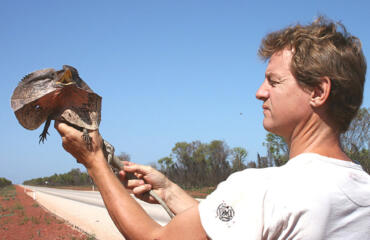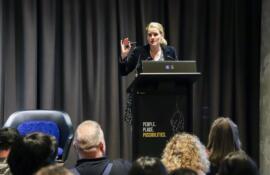‘I worked with a panel of supervisors to create experiments that would reveal how the South American Opossum recovers from spinal injury. I observed and documented the recovery process under a microscope and through movement testing.
The opossum was chosen because it is a marsupial. Marsupials are born at a very immature stage of development.
The reason we use them for this kind of work is that you can study developmental stages that you would only have access to in a mouse or a rat from within the womb of the mother.
Early experimentation is useful for spinal study because in immature animals the spinal cord is still developing.
‘These opossums recovered very well from their injury, regaining something like 90 per cent of their movement as mature animals, which is amazing.’
Nerve cells can grow through an injury site partly because the younger animal does not develop large amounts of scar tissue when injured.
The animal also displays early growth characteristics, such as neuroplasticity, which help nerves to grow again after they have been cut.
A grown opossum has a strong inflammatory response to injury, which creates scar tissue. It is very difficult for nerves to grow through a scarred area.
To make things more complicated, nerve cells are already formed in a grown opossum. When an established nerve is cut it is very unlikely to grow again. This is also the case for humans.
In my experiments I worked with seven-day-old and 28-day-old opossums.
The spinal cords of test animals were cut with very fine scissors to create a spinal injury similar to what happens when a human spinal cord is severed in an accident.
When the spinal cord was cut seven days after birth the nervous tissue showed a remarkable tendency to reform and reconnect over the injury site.

These opossums recovered very well from their injury, regaining something like 90 per cent of their movement as mature animals, which is amazing. Unfortunately this is nothing like what we see in human recovery.
When the spinal cord of the opossum was cut 28 days after birth there was no re-growth of nervous tissue through the injury site.
This is more like what happens in a human injury. For humans such an injury will generally mean irreversible, severe paralysis.
For the opossum you would expect this lack of nerve tissue growth to result in very poor function, but it turned out they could move quite well.
In these cases it looked like the opossum relied on its propriospinal system for movement recovery. I was particularly interested in observing this aspect.
A propriospinal neuron is contained entirely within the spinal cord and does not start out in the brain. These neurons are used for organization between spinal segments.The spinal cord has two neural systems. One is supraspinal, meaning “from the brain down”, and the other is propriospinal, meaning “contained within”.
When you perform any task that involves your spinal cord, so any body movement at all, the brain does not control all the processes that make up that movement.
‘We hope this understanding may lead to effective therapies for human recovery, but the slow nature of this research means that any human application is still decades away.’
Your brain gives the order to walk, but it is the propriospinal neurons that handle timing, lifting the feet and muscle coordination in a system called the central pattern generator.
A lot of body movement is directed by information from the outside world that reaches the nervous system through receptors. For example, if your feet sense a sharp rock you will not put your full weight on it.
It seems that the opossum can still receive information via these receptors despite spinal injury. Unfortunately humans with a spinal injury do not recover the use of their propriospinal system to a sufficient degree for sensory information to allow them to walk and bear their own weight.
My plan is to learn more about how the opossum uses its propriospinal system for movement after injury.
We hope this understanding may lead to effective therapies for human recovery, but the slow nature of this research means that any human application is still decades away.
I’m heading over to New Mexico soon to continue with this study in one of only four laboratories in the world that work with the South American Opossum. I will be joining a team of researchers to look further into how the recovery process in the opossum works.’
Benjamin Wheaton’s thesis is titled: “Recovery from complete spinal transection in the developing opossum, Monodelphis domestica.”
*My PhD is an irregular series in which The Citizen speaks with recent Melbourne University PhD graduates.



